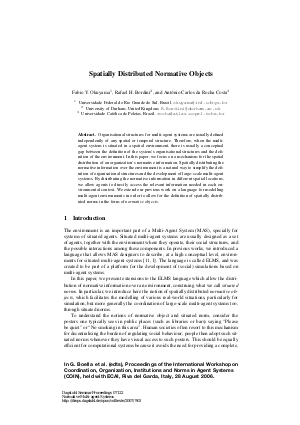Spatially Distributed Normative Objects
Authors Fabio Okuyama, Rafael Bordini, Antônio Carlos Rocha Costa
-
Part of:
Volume:
Dagstuhl Seminar Proceedings, Volume 7122
Part of: Series: Dagstuhl Seminar Proceedings (DagSemProc) - License:
 Creative Commons Attribution 4.0 International license
Creative Commons Attribution 4.0 International license
- Publication Date: 2007-03-12
File

PDF
DagSemProc.07122.26.pdf
- Filesize: 275 kB
- 14 pages
Document Identifiers
Subject Classification
Keywords
- Multi-Agent Systems
- Environment Modelling
- Normative Infrastructure
Metrics
- Access Statistics
-
Total Accesses (updated on a weekly basis)
0Document
0Metadata
Abstract
Organisational structures for multi-agent systems are usually defined independently of any spatial or temporal structure. Therefore, when the multiagent system is situated in a spatial environment, there is usually a conceptual gap between the definition of the system’s organisational structures and the definition of the environment. In this paper, we focus on a mechanism for the spatial distribution of an organization’s normative information. Spatially distributing the normative information over the environment is a natural way to simplify the definition of organisational structures and the development of large-scale multi-agent systems. By distributing the normative information in different spatial locations, we allow agents to directly access the relevant information needed in each environmental context. We extend our previous work on a language for modelling multi-agent environments in order to allow for the definition of spatially distributed norms in the form of normative objects.
Cite As Get BibTex
Fabio Okuyama, Rafael Bordini, and Antônio Carlos Rocha Costa. Spatially Distributed Normative Objects. In Normative Multi-agent Systems. Dagstuhl Seminar Proceedings, Volume 7122, pp. 1-14, Schloss Dagstuhl – Leibniz-Zentrum für Informatik (2007)
https://doi.org/10.4230/DagSemProc.07122.26
BibTex
@InProceedings{okuyama_et_al:DagSemProc.07122.26,
author = {Okuyama, Fabio and Bordini, Rafael and Rocha Costa, Ant\^{o}nio Carlos},
title = {{Spatially Distributed Normative Objects}},
booktitle = {Normative Multi-agent Systems},
pages = {1--14},
series = {Dagstuhl Seminar Proceedings (DagSemProc)},
ISSN = {1862-4405},
year = {2007},
volume = {7122},
editor = {Guido Boella and Leon van der Torre and Harko Verhagen},
publisher = {Schloss Dagstuhl -- Leibniz-Zentrum f{\"u}r Informatik},
address = {Dagstuhl, Germany},
URL = {https://drops.dagstuhl.de/entities/document/10.4230/DagSemProc.07122.26},
URN = {urn:nbn:de:0030-drops-9030},
doi = {10.4230/DagSemProc.07122.26},
annote = {Keywords: Multi-Agent Systems, Environment Modelling, Normative Infrastructure}
}
